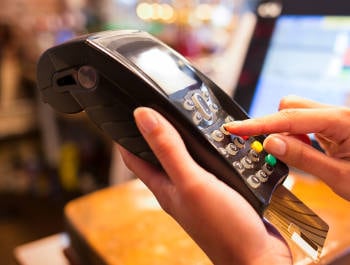
An EMV card reader with cared being “dipped”
After October 1st, 2015, the American payment card industry is officially starting the switch to “EMV” cards, or chip cards. These new kinds of cards have a chip in them (thus the name) that interacts with card readers in a way that makes them harder to copy and more resistant to fraud.
Sounds great, right? It is pretty good, but it does put some new responsibilities on merchants (that’s us — we are called “merchants” in this scenario.)
Here’s the breakdown of our new responsibilities:
- We need a special reader to be able to take these cards. These readers are much more complex than the classic swipers that we’ve been using, and they will cost some money to buy. (more below)
- If a client pays you with a credit card that is equipped with the EMV chip, and you don’t use an EMV chip card reader to accept the payment, you will most likely by highly liable if the payment turns out to be fraudulent.
There is a bit to unpack about those two items. But first, the quick answer to the most basic question:
Do I Need To Buy a New Card Reader For My Practice?
In my opinion, it depends on your timeframe:
- Immediately? Probably not, unless it’s convenient to do so. If it is convenient for you, definitely do so.
- In the nearish future? Probably, especially if it’s reasonable to do so.
- Eventually? Yes, without question.
How Does The New Liability Situation Work?
 As a non-lawyer, I can’t speak to the nitty-gritty details. However, it is essentially a situation of:
As a non-lawyer, I can’t speak to the nitty-gritty details. However, it is essentially a situation of:
If a “customer” (the client) wants to pay you with one of the shiny new EMV chip cards, there is a hope that you will accommodate them with a shiny new EMV chip card reader.
The industry hopes you’ll do this because the EMV system reduces fraud. So they have arranged it such that if you don’t use an EMV reader when your “customer” (the client) offers up an EMV card, then it’s on your head if the payment turns out to be fraudulent.
“But Roy,” some of you are now saying, “I’ve never ever had a single problem with credit card fraud in my practice.”Neither have I! And that’s why my answer to the question of, “Do I Need To Buy a New Card Reader For My Practice?” is a bit wishy-washy. It’s all about risk management…
Cost-Benefit Analysis
 As most of you know, I am a big fan of risk management thinking. A vital part of risk management thinking is cost-benefit analysis.
As most of you know, I am a big fan of risk management thinking. A vital part of risk management thinking is cost-benefit analysis.
The benefits of getting an EMV chip card reader are:
- Systemic: By doing so, you take part in reducing overall credit card fraud in the US and thus reduce the odds that your clients will be victims of such fraud. Clearly, this is a Good Thing.
- Regulatory: Getting an EMV chip card reader is now incentivized by the potential for high liability when fraud occurs.
- Monetary: Getting an EMV chip card reader reduces the risk of having to return money if a payment turns out to be fraudulent.
Because credit card fraud is super rare in our industry (think about how it would go down if a client paid you with a fake credit card), items number 2 and 3 carry little weight in the cost-benefit analysis for most practices (the exceptions to this statement will likely know who you are.)
The value of the systemic benefit (item 1), however, is dependent on the state of the system and how much influence I can have on changing the state of the system.
If all my clients are trying to pay me with chip cards, then not having a chip card reader would be a drain on the social system.
If none of my clients are trying to pay with chip cards, then having a chip card reader makes no difference to the social system.
According to Square’s report about EMV’s presence in the US (as of October 2015), about 17% of cards run through Square at this time have EMV chips in them.
If we go with Square’s stats as universally applicable, and if my caseload is 20 clients, then that means 3-4 of them probably have EMV chip cards (once again, as of October 2015.)
So in the cost-benefit analysis, I need to weigh the value to those 3-4 people of my having an EMV card reader vs. the cost of getting one.
I also need to consider that banks and other financial folks will be replacing our classic cards with EMV chip cards in the near future. That means the benefit of my getting an EMV chip card reader is guaranteed to increase as time goes on.
And with that, I bring you the next section of this article:
Our free, informative articles are brought to you by Hushmail,
who is offering our readers 15% off for life!
Wondering why this is here? See our sponsorship policy for details.

 Roy says: Hushmail is one of several secure email options that serves health care practitioners like us. Hushmail is highly trusted, affordable, includes secure web forms that accept e-signatures, and has earned a recommendation from us for use by mental health professionals. Learn more about Hushmail for Healthcare and get 15% off for life.
Roy says: Hushmail is one of several secure email options that serves health care practitioners like us. Hushmail is highly trusted, affordable, includes secure web forms that accept e-signatures, and has earned a recommendation from us for use by mental health professionals. Learn more about Hushmail for Healthcare and get 15% off for life.
What Is My Cost In Getting an EMV Reader?
 Unfortunately, it’s a bit more onerous than it is to get the simple swiper doohickeys that are supplied by mobile payment apps like Square and PayPal Here. In the long-run, however, it isn’t all that bad.
Unfortunately, it’s a bit more onerous than it is to get the simple swiper doohickeys that are supplied by mobile payment apps like Square and PayPal Here. In the long-run, however, it isn’t all that bad.
EMV chip card readers do a lot more than a swiper does and require actual computing capabilities. When the client gives you an EMV card, the card is “dipped” into your reader. It is inserted part-way into the reader and remains there until the transaction is complete.
The PayPay Here EMV reader is currently being sold with the classic rebate bait-n-switch. It’s $149 but you get a $100 rebate if you run at least $3000 of charges within 3 months of getting the reader.
If the majority of your clients pay with a credit card then that’s easily doable, and so the reader would essentially be $49. Otherwise, it would be $149.
Once again, we see that the benefit of getting an EMV reader is relative to how many of our clients would get value from it.
Square is advertising two kinds of EMV reader. One is a simpler EMV/swiper combo reader for $29 and it is available now. They are taking reservations for an EMV reader that can also do wireless payments such as Apple Pay (which is another significant improvement in payment card safety.) This super fancy reader isn’t out yet, but you can reserve one. And they state it will cost $49.
You should see what these EMV readers look like, too. You can find pictures of PayPal’s reader and Square’s reader here:
So, What Does “EMV” Stand For?
It stands for “Europay, Mastercard, and Visa.”
Yep, it’s not that interesting. That’s why we just call it “EMV.”
Our Recommendations
 We recommend that all clinicians who accept credit cards take a little time to find out how they would acquire an EMV reader that works with their credit card provider. We talked about Square and PayPal, but there are many such providers out there.
We recommend that all clinicians who accept credit cards take a little time to find out how they would acquire an EMV reader that works with their credit card provider. We talked about Square and PayPal, but there are many such providers out there.
Consider the cost of the reader and decide if it is worth that cost at this time. If it isn’t useful right now, perhaps make a plan for when you will buy one in the future. Or, if you use credit card transactions very little, make a plan for when you will simply revisit the question of getting an EMV reader.
I know I will probably get one of Square’s EMV readers around the New Year. It’ll be one of those practical Christmas presents, like buying myself a vacuum cleaner.

I always appreciate your posts Roy! Thanks for sharing this info with us. My credit card merchant provider, sent me a new EMV reader for use with my smart phone at no cost to me. I have a small practice and of course I know all my clients and am not concerned at all about a client using a fraudulent card. If I had to buy a new reader I would probably wait until it was absolutely necessary.
Thank you Roy for such a clear exposition of this technology change — particularly because things are still in flux — and the cost benefit analysis which enabled me to imagine myself along a continuum of how many clients have these cards, etc etc. Your abilities in these areas and willingness to share this information is a true gift to our community. Plus your humor is always a good thing.
Oh, that’s quite nice of them! Who is your provider?
Excellent. It sounds like I accomplished my goal with this one!
I’m using First Data now and have been happy enough with them. Being a credit card merchant is no easy task though. There are by far easier options, but they also tend to cost a little more and I don’t have as much control with regard to HIPAA privacy.
It certainly sounds like they deliver good service. A free EMV reader is quite nice! :)
Thanks, Roy. That was a very clear explanation. I really appreciate your help with the technical aspects of our profession!
You’re very welcome!
This is so helpful, thanks for writing something so easy to read and understand! Your blog is a wonderful resource.
You’re very welcome! :)
Hi Roy! Quick questions-
1) I tried to find the “paypay here” reader you have cited in the article, but I only get results for paypal. It looks like the chip reader is $79 now through paypal. Is that the one you were referring to that previously was more expensive + had a rebate?’
2) I am trying to find information about what system of credit card processing + billing is most convenient and cost effective to use, interfacing with Therapynotes. Do you happen to have an article to point me to, or opinions?
Many thanks!
Hi, Tati!
1) This article was first published in 2015, so there have definitely been changes and updates to card readers since then — and prices should have come down as the technology isn’t as new/there’s more competition in the market. Whatever options directly offered from PayPal should be good for use with PayPal.
2) We don’t have any articles or suggestions regarding systems to interface with TherapyNotes for card processing and billing. Our recommendation would be to ask TherapyNotes for their suggestions; they should know what interfaces best with their platform.
Best of luck!
I don’t know about a system that integrates with Therapynotes, but IVY Pay is an awesome, secure, HIPAA compliant, easy to use credit card processing system that was designed for therapists. I don’t work for them and am not a representative of their company. They’re offering $1000 in free charges right now. http://www.talktoivy.com/ivypay
Hi Tati,
TherapyNotes is fully integrated with First Data for credit card processing features. The costs are roughly the same as Square (I even save some money), but where I really save is time. Since it’s completely integrated, I never have to go back and enter data into the system. They also let me store credit cards and charge them as needed.
Hi Roy,
Your articles are so extremely helpful. I am about to finally take the plunge and start accepting credit cards. I’m thinking Square sounds the easiest and most affordable at this point (although I’m open to other’s opinions on that). I’m wondering if you think it’s worth it now to purchase the $29 chip card reader or the $49 Contactless + chip reader? I’ve had the the regular Magstripe reader sitting in a drawer for the last year, but never activated my account with Square because I wanted to avoid the fees for as long as possible. Trying to figure out if I should just start using that or order one of the chip readers now. Thanks for any input!
I still don’t see there being a lot of risk of clients paying for therapy sessions with fraudulent card charges. So for me, personally, I still use the swiper.
Thanks! Appreciate the input!